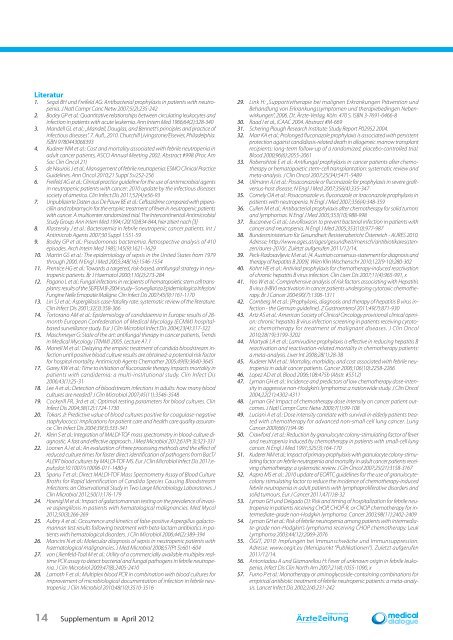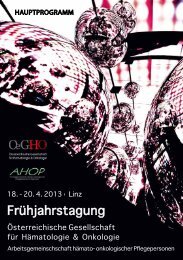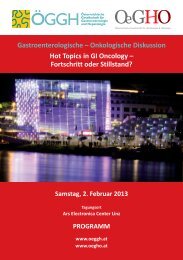febrile Neutropenie - OeGHO
febrile Neutropenie - OeGHO
febrile Neutropenie - OeGHO
Erfolgreiche ePaper selbst erstellen
Machen Sie aus Ihren PDF Publikationen ein blätterbares Flipbook mit unserer einzigartigen Google optimierten e-Paper Software.
Die Zeitschrift der Ärztinnen und Ärzte<br />
Literatur<br />
1. Segal BH und Freifeld AG: Antibacterial prophylaxis in patients with neutropenia.<br />
J Natl Compr Canc Netw 2007;5(2):235-242<br />
2. Bodey GP et al.: Quantitative relationships between circulating leukocytes and<br />
infection in patients with acute leukemia. Ann Intern Med 1966;64(2):328-340<br />
3. Mandell GL et al.: „Mandell, Douglas, and Bennett‘s principles and practice of<br />
infectious diseases“. 7. Aufl., 2010. Churchill Livingstone/Elsevier, Philadelphia.<br />
ISBN 9780443068393<br />
4. Kuderer NM et al.: Cost and mortality associated with <strong>febrile</strong> neutropenia in<br />
adult cancer patients, ASCO Annual Meeting 2002. Abstract #998 (Proc Am<br />
Soc Clin Oncol 21)<br />
5. de Naurois J et al.: Management of <strong>febrile</strong> neutropenia: ESMO Clinical Practice<br />
Guidelines. Ann Oncol 2010;21 Suppl 5:v252-256<br />
6. Freifeld AG et al.: Clinical practice guideline for the use of antimicrobial agents<br />
in neutropenic patients with cancer: 2010 update by the infectious diseases<br />
society of america. Clin Infect Dis 2011;52(4):e56-93<br />
7. Unpublizierte Daten aus De Pauw BE et al.: Ceftazidime compared with piperacillin<br />
and tobramycin for the empiric treatment of fever in neutropenic patients<br />
with cancer. A multicenter randomized trial. The Intercontinental Antimicrobial<br />
Study Group. Ann Intern Med 1994;120(10):834-844, hier zitiert nach [3]<br />
8. Klastersky J et al.: Bacteraemia in <strong>febrile</strong> neutropenic cancer patients. Int J<br />
Antimicrob Agents 2007;30 Suppl 1:S51-59<br />
9. Bodey GP et al.: Pseudomonas bacteremia. Retrospective analysis of 410<br />
episodes. Arch Intern Med 1985;145(9):1621-1629<br />
10. Martin GS et al.: The epidemiology of sepsis in the United States from 1979<br />
through 2000. N Engl J Med 2003;348(16):1546-1554<br />
11. Prentice HG et al.: Towards a targeted, risk-based, antifungal strategy in neutropenic<br />
patients. Br J Haematol 2000;110(2):273-284<br />
12. Pagano L et al.: Fungal infections in recipients of hematopoietic stem cell transplants:<br />
results of the SEIFEM B-2004 study--Sorveglianza Epidemiologica Infezioni<br />
Fungine Nelle Emopatie Maligne. Clin Infect Dis 2007;45(9):1161-1170<br />
13. Lin SJ et al.: Aspergillosis case-fatality rate: systematic review of the literature.<br />
Clin Infect Dis 2001;32(3):358-366<br />
14. Tortorano AM et al.: Epidemiology of candidaemia in Europe: results of 28-<br />
month European Confederation of Medical Mycology (ECMM) hospitalbased<br />
surveillance study. Eur J Clin Microbiol Infect Dis 2004;23(4):317-322<br />
15. Maschmeyer G: State of the art: antifungal therapy in cancer patients, Trends<br />
in Medical Mycology (TIMM) 2005. Lecture A1.1<br />
16. Morrell M et al.: Delaying the empiric treatment of candida bloodstream infection<br />
until positive blood culture results are obtained: a potential risk factor<br />
for hospital mortality. Antimicrob Agents Chemother 2005;49(9):3640-3645<br />
17. Garey KW et al.: Time to initiation of fluconazole therapy impacts mortality in<br />
patients with candidemia: a multi-institutional study. Clin Infect Dis<br />
2006;43(1):25-31<br />
18. Lee A et al.: Detection of bloodstream infections in adults: how many blood<br />
cultures are needed? J Clin Microbiol 2007;45(11):3546-3548<br />
19. Cockerill FR, 3rd et al.: Optimal testing parameters for blood cultures. Clin<br />
Infect Dis 2004;38(12):1724-1730<br />
20. Tokars JI: Predictive value of blood cultures positive for coagulase-negative<br />
staphylococci: implications for patient care and health care quality assurance.<br />
Clin Infect Dis 2004;39(3):333-341<br />
21. Klein S et al.: Integration of MALDI-TOF mass spectrometry in blood-culture diagnostic.<br />
A fast and effective approach. J Med Microbiol 2012;61(Pt 3):323-331<br />
22. Loonen AJ et al.: An evaluation of three processing methods and the effect of<br />
reduced culture times for faster direct identification of pathogens from BacT/<br />
ALERT blood cultures by MALDI-TOF MS. Eur J Clin Microbiol Infect Dis 2011;epub;doi:10.1007/s10096-011-1480-y<br />
23. Spanu T et al.: Direct MALDI-TOF Mass Spectrometry Assay of Blood Culture<br />
Broths for Rapid Identification of Candida Species Causing Bloodstream<br />
Infections: an Observational Study in Two Large Microbiology Laboratories. J<br />
Clin Microbiol 2012;50(1):176-179<br />
24. Hoenigl M et al.: Impact of galactomannan testing on the prevalence of invasive<br />
aspergillosis in patients with hematological malignancies. Med Mycol<br />
2012;50(3):266-269<br />
25. Aubry A et al.: Occurrence and kinetics of false-positive Aspergillus galactomannan<br />
test results following treatment with beta-lactam antibiotics in patients<br />
with hematological disorders. J Clin Microbiol 2006;44(2):389-394<br />
26. Mancini N et al.: Molecular diagnosis of sepsis in neutropenic patients with<br />
haematological malignancies. J Med Microbiol 2008;57(Pt 5):601-604<br />
27. von Lilienfeld-Toal M et al.: Utility of a commercially available multiplex realtime<br />
PCR assay to detect bacterial and fungal pathogens in <strong>febrile</strong> neutropenia.<br />
J Clin Microbiol 2009;47(8):2405-2410<br />
28. Lamoth F et al.: Multiplex blood PCR in combination with blood cultures for<br />
improvement of microbiological documentation of infection in <strong>febrile</strong> neutropenia.<br />
J Clin Microbiol 2010;48(10):3510-3516<br />
29. Link H: „Supportivtherapie bei malignen Erkrankungen Prävention und<br />
Behandlung von Erkrankungssymptomen und therapiebedingen Nebenwirkungen”,<br />
2006. Dt. Ärzte-Verlag, Köln. 470 S. ISBN 3-7691-0466-8<br />
30. Raad I et al., ICAAC 2004. Abstract #M-669<br />
31. Schering Plough Research Institute: Study Report P02952 2004.<br />
32. Marr KA et al.: Prolonged fluconazole prophylaxis is associated with persistent<br />
protection against candidiasis-related death in allogeneic marrow transplant<br />
recipients: long-term follow-up of a randomized, placebo-controlled trial.<br />
Blood 2000;96(6):2055-2061<br />
33. Robenshtok E et al.: Antifungal prophylaxis in cancer patients after chemotherapy<br />
or hematopoietic stem-cell transplantation: systematic review and<br />
meta-analysis. J Clin Oncol 2007;25(34):5471-5489<br />
34. Ullmann AJ et al.: Posaconazole or fluconazole for prophylaxis in severe graftversus-host<br />
disease. N Engl J Med 2007;356(4):335-347<br />
35. Cornely OA et al.: Posaconazole vs. fluconazole or itraconazole prophylaxis in<br />
patients with neutropenia. N Engl J Med 2007;356(4):348-359<br />
36. Cullen M et al.: Antibacterial prophylaxis after chemotherapy for solid tumors<br />
and lymphomas. N Engl J Med 2005;353(10):988-998<br />
37. Bucaneve G et al.: Levofloxacin to prevent bacterial infection in patients with<br />
cancer and neutropenia. N Engl J Med 2005;353(10):977-987<br />
38. Bundesministerium für Gesundheit: Resistenzbericht Österreich - AURES 2010.<br />
Adresse: http://www.ages.at/ages/gesundheit/mensch/antibiotikaresistenzen/aures-2010/.<br />
Zuletzt aufgerufen 2011/12/14.<br />
39. Peck-Radosavljevic M et al.: [4. Austrian consensus-statement for diagnosis and<br />
therapy of hepatitis B 2009]. Wien Klin Wochenschr 2010;122(9-10):280-302<br />
40. Kohrt HE et al.: Antiviral prophylaxis for chemotherapy-induced reactivation<br />
of chronic hepatitis B virus infection. Clin Liver Dis 2007;11(4):965-991, x<br />
41. Yeo W et al.: Comprehensive analysis of risk factors associating with Hepatitis<br />
B virus (HBV) reactivation in cancer patients undergoing cytotoxic chemotherapy.<br />
Br J Cancer 2004;90(7):1306-1311<br />
42. Cornberg M et al.: [Prophylaxis, diagnosis and therapy of hepatitis B virus infection<br />
- the German guideline]. Z Gastroenterol 2011;49(7):871-930<br />
43. Artz AS et al.: American Society of Clinical Oncology provisional clinical opinion:<br />
chronic hepatitis B virus infection screening in patients receiving cytotoxic<br />
chemotherapy for treatment of malignant diseases. J Clin Oncol<br />
2010;28(19):3199-3202<br />
44. Martyak LA et al.: Lamivudine prophylaxis is effective in reducing hepatitis B<br />
reactivation and reactivation-related mortality in chemotherapy patients:<br />
a meta-analysis. Liver Int 2008;28(1):28-38<br />
45. Kuderer NM et al.: Mortality, morbidity, and cost associated with <strong>febrile</strong> neutropenia<br />
in adult cancer patients. Cancer 2006;106(10):2258-2266<br />
46. Lopez AD et al. Blood 2006;108:475b (Abstr. #5512)<br />
47. Lyman GH et al.: Incidence and predictors of low chemotherapy dose-intensity<br />
in aggressive non-Hodgkin’s lymphoma: a nationwide study. J Clin Oncol<br />
2004;22(21):4302-4311<br />
48. Lyman GH: Impact of chemotherapy dose intensity on cancer patient outcomes.<br />
J Natl Compr Canc Netw 2009;7(1):99-108<br />
49. Luciani A et al.: Dose intensity correlate with survival in elderly patients treated<br />
with chemotherapy for advanced non-small cell lung cancer. Lung<br />
Cancer 2009;66(1):94-96<br />
50. Crawford J et al.: Reduction by granulocyte colony-stimulating factor of fever<br />
and neutropenia induced by chemotherapy in patients with small-cell lung<br />
cancer. N Engl J Med 1991;325(3):164-170<br />
51. Kuderer NM et al.: Impact of primary prophylaxis with granulocyte colony-stimulating<br />
factor on <strong>febrile</strong> neutropenia and mortality in adult cancer patients receiving<br />
chemotherapy: a systematic review. J Clin Oncol 2007;25(21):3158-3167<br />
52. Aapro MS et al.: 2010 update of EORTC guidelines for the use of granulocytecolony<br />
stimulating factor to reduce the incidence of chemotherapy-induced<br />
<strong>febrile</strong> neutropenia in adult patients with lymphoproliferative disorders and<br />
solid tumours. Eur J Cancer 2011;47(1):8-32<br />
53. Lyman GH und Delgado DJ: Risk and timing of hospitalization for <strong>febrile</strong> neutropenia<br />
in patients receiving CHOP, CHOP-R, or CNOP chemotherapy for intermediate-grade<br />
non-Hodgkin lymphoma. Cancer 2003;98(11):2402-2409<br />
54. Lyman GH et al.: Risk of <strong>febrile</strong> neutropenia among patients with intermediate-grade<br />
non-Hodgkin’s lymphoma receiving CHOP chemotherapy. Leuk<br />
Lymphoma 2003;44(12):2069-2076<br />
55. ÖGIT, 2010: Impfungen bei Immunschwäche und Immunsuppression.<br />
Adresse: www.oegit.eu (Menüpunkt “Publikationen”). Zuletzt aufgerufen<br />
2011/12/14.<br />
56. Antoniadou A und Giamarellou H: Fever of unknown origin in <strong>febrile</strong> leukopenia.<br />
Infect Dis Clin North Am 2007;21(4):1055-1090, x<br />
57. Furno P et al.: Monotherapy or aminoglycoside-containing combinations for<br />
empirical antibiotic treatment of <strong>febrile</strong> neutropenic patients: a meta-analysis.<br />
Lancet Infect Dis 2002;2(4):231-242<br />
14 Supplementum ■ April 2012







